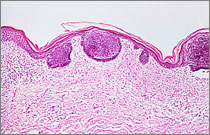Cancer of the uterus (endometrial cancer)
| 2020 | |
|---|---|
¹ per 100,000 persons, age-standardised according to the old European standard population * calculated using the period method for 2019 / 2020 | |
| Women | |
| Incidence | 10,860 |
| Age-standardised incidence rate¹ | 15.8 |
| Deaths | 2,785 |
| Age-standardised mortality rate¹ | 3.1 |
| 5-year prevalence | 44,900 |
| 10-year prevalence | 79,100 |
| Relative 5-year survival rate* | 78 % |
| Relative 10-year survival rate* | 75 % |
With about 10,860 new cases every year, malignant tumours of the uterine body (endometrial cancer) are the fifth most common cancer in women and the most common of the female genital organs. Due to the good prognosis, the number of deaths from this disease is comparatively low at around 2,660 per year. One in 50 women will develop uterine cancer over the course of their lifetime, and one in 200 will die of it. The incidence rate of uterine cancer is slightly decreasing, while the age-standardised mortality rate has remained fairly constant in recent years.

![]() Age-standardised incidence and mortality rates, ICD-10 C54–C55, Germany 1999 – 2016/2017, projection (incidence) through 2020, per 100,000 (old European standard population)
Age-standardised incidence and mortality rates, ICD-10 C54–C55, Germany 1999 – 2016/2017, projection (incidence) through 2020, per 100,000 (old European standard population)
The average age at diagnosis is 67 years. Histologically, cancers of the uterine body are mostly endometrial adenocarcinomas arising from the mucous membrane of the uterus.
The relative 5-year survival rate in Germany is about 78 percent. At the end of 2020, there were about 145,900 women living in Germany who had been diagnosed with uterine cancer in the previous 25 years.
Hormones influence the risk of disease
About 80 percent of endometrial carcinomas are hormone dependent. For these, oestrogen exposure is a risk factor: an early menarche (first menstrual period), late menopause as well as childlessness or diseases of the ovaries increase risk. Oestrogen monotherapy during menopause also increases risk, which can be counteracted by combination with gestagens. Oral contraceptives (birth control pills), especially estrogen-progestin combinations, reduce risk. Excess weight and lack of exercise also play a role in hormone-dependent tumours. In addition, women with diabetes mellitus type 2 are more likely to develop uterine cancer. Women who are treated with tamoxifen for breast cancer also have a higher risk. Gene mutations associated with hereditary colorectal cancer (non-polyposis colorectal cancer) also increase the risk of uterine cancer.
For the rarer forms of uterine cancer that are not affected by oestrogen, higher age and radiation of the uterus can increase risk. It is not clear what role lifestyle or genetic factors play.
Date: 29.04.2024






